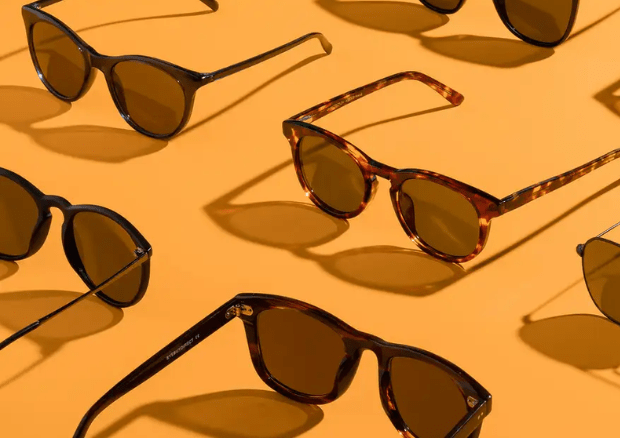The ultimate guide to progressive sunglasses

What are Progressive Sunglasses?
Progressive lenses, also known as multifocal lenses, allow you to see clearly at multiple distances without the distracting line that bifocals give. This smooth transition means that you can swap seamlessly between distance and near tasks.
Progressive sunglasses are progressive lenses that have been tinted or polarized. This will protect you from glare and UV rays outdoors while still helping you to see at all distances.
Progressive Sunglasses Benefits
Progressive sunglasses are a great option for people who don’t want to swap between multiple sets of glasses while doing activities outdoors. Some benefits of progressive sunglasses include:
- Convenient – Progressive sunglasses provide you with clear vision while performing tasks at all distances. You will no longer require a separate set of reading and distance glasses, which saves you from swapping between multiple sets of glasses while outdoors.
- Cost effective – By purchasing only one set of glasses, as opposed to a separate set of reading and distance glasses, you will save money on frames, lenses, and coatings.
- UV and glare protection – Progressive sunglasses will protect your eyes from damaging UV rays, while also filtering out bright lights.
- More aesthetically pleasing than bifocal lenses – As progressive lenses have a smooth transition between lens power, there is no unappealing line through the lens.
Types of Progressive Lenses
There are many different types of progressive lenses, with specialized designs to cater for your lifestyle. Some popular progressive lens types include:
- Standard progressive lenses – A basic, non-specialized progressive lens design. Standard lenses are a more affordable option and provide a wide reading zone.
- Premium progressive lenses – These lenses are made with more advanced technology than standard lenses, which provides a much wider area of clear vision. Premium lenses are much easier to adapt to due to the smaller amount of distortion on the edges of the lens.
- Short corridor progressive lenses – Short corridor lenses have a smaller lens size, meaning that they are more suitable for smaller frames. However, the limited lens size means that these lenses are less practical than other options.
- Computer progressive lenses – These lenses are designed for office use and reduce digital eye strain. Computer progressive lenses are more suited to indoor use and are great for people who use the computer for over 4 hours a day.
- Ground-view progressive lenses – Ground-view lenses provide a very wide field of vision with a small amount of peripheral distortion. These lenses are particularly beneficial for people who spend a lot of time outdoors.
- Transition progressive lenses – These lenses are photochromatic, which means that the lenses are clear indoors (like regular glasses) and darken when they are exposed to UV rays outdoors. Transition lenses are great for people who want one pair of glasses that will work indoors and provide sun and glare protection outdoors.
When it comes to purchasing progressive sunglasses, it is important to consider what type of tasks you will be using your glasses for. Lens types such as short corridor lenses and computer progressive lenses are less suitable for sunglasses. This is because the distance vision zone is much smaller than in other lens types.
The premium progressive lenses are most popular for a general pair of progressive sunglasses, as they give a large field of view and are easy to adapt to. If you are spending a lot of time outdoors, it may be worth investing in ground-view progressive lenses as they provide a very large zone of distance vision.
Best Frames for Progressive Sunglasses

When purchasing progressive sunglasses, it’s important to make sure that your frame is suitable. Some things to consider while selecting your frames include:
- Size – A frame that is too small will limit your vision. This is because progressive lenses need to fit your distance and your near vision powers into the lenses. When selecting sunglasses, many people will opt for a larger frame size.
- Shape – Sunglasses frames that are too curved (such as wrap frames) can cause your vision to become distorted if you are getting progressive lenses. While some lens designs will work with wrap sunglasses, there is a limited amount of frame adjustments that can be made to improve your vision with these frames if they are not fitting well.
Polarized Progressive Sunglasses
Polarized sunglasses filter out more glare and reflections than regular tinted sunglasses. This will provide much clearer vision and alleviates eye strain. Having polarized glasses is great for people who spend a lot of time outdoors, whether that be on the water or driving. Because polarizing reduces horizontal light reflections, you can see more clearly around water or in wet driving conditions.
Maximum Glare Reduction
If you are spending a lot of time outdoors, it is important to consider extra protection against glare. While sunglasses will reduce the brightness of lights outdoors, extra coatings will help to reduce as much glare as possible. Two ways of achieving maximum glare reduction are:
- Premium Anti-Glare Coating – This is a coating applied to the back surface of the glasses lens, which will reduce glare and reflections.
- Mirror Coating – This coating will reflect light away from the eye, which provides maximum glare protection. Mirror coated sunglasses are also aesthetically pleasing and prevent people from seeing your eyes through your lenses.
How to Order Progressive Sunglasses
Getting your own pair of progressive sunglasses is easier than you might think. Here’s an overview of the processGetting your own pair of progressive sunglasses from Overnight Glasses is easier than you might think. And even more, you can get them with the fastest shipping. Here’s an overview of the process:
- Choose your frame – First, select the frame you would like to use for your sunglasses. Remember to pick a frame that will allow you enough vision through all of your prescription zones.
- Select the progressive lens type – This is where you will select progressive lenses, as opposed to a single vision lens (for only one set distance).
- Pick the right progressive lens design for your lifestyle – Here you will select the best lens type for your needs. If you will spend a lot of time doing distance tasks (such as driving), it’s a good idea to consider a lens that will prioritize your distance vision.
- Enter your prescription – This is where you will enter your prescription so that your glasses will be made to provide you the best possible vision.
- Select your lens package – This includes any tints, polarizing, or coatings that you would like to add to your lenses. You can customize your glasses in this step, adding any colors or features that you would like included.
